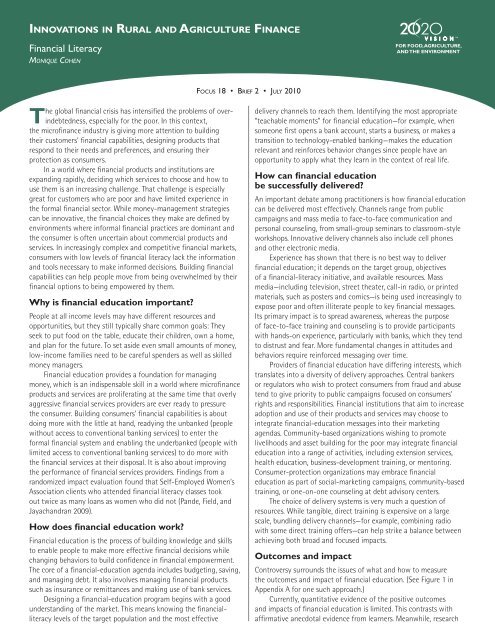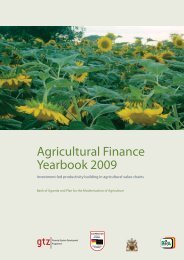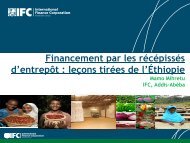Innovations in Rural and Agriculture Finance
Innovations in Rural and Agriculture Finance
Innovations in Rural and Agriculture Finance
You also want an ePaper? Increase the reach of your titles
YUMPU automatically turns print PDFs into web optimized ePapers that Google loves.
<strong>Innovations</strong> <strong>in</strong> <strong>Rural</strong> <strong>and</strong> <strong>Agriculture</strong> F<strong>in</strong>anceF<strong>in</strong>ancial LiteracyMonique CohenFor Food, <strong>Agriculture</strong>,<strong>and</strong> the Environmenthe global f<strong>in</strong>ancial crisis has <strong>in</strong>tensified the problems of over<strong>in</strong>debtedness,especially for the poor. In this context,Tthe microf<strong>in</strong>ance <strong>in</strong>dustry is giv<strong>in</strong>g more attention to build<strong>in</strong>gtheir customers’ f<strong>in</strong>ancial capabilities, design<strong>in</strong>g products thatrespond to their needs <strong>and</strong> preferences, <strong>and</strong> ensur<strong>in</strong>g theirprotection as consumers.In a world where f<strong>in</strong>ancial products <strong>and</strong> <strong>in</strong>stitutions areexp<strong>and</strong><strong>in</strong>g rapidly, decid<strong>in</strong>g which services to choose <strong>and</strong> how touse them is an <strong>in</strong>creas<strong>in</strong>g challenge. That challenge is especiallygreat for customers who are poor <strong>and</strong> have limited experience <strong>in</strong>the formal f<strong>in</strong>ancial sector. While money-management strategiescan be <strong>in</strong>novative, the f<strong>in</strong>ancial choices they make are def<strong>in</strong>ed byenvironments where <strong>in</strong>formal f<strong>in</strong>ancial practices are dom<strong>in</strong>ant <strong>and</strong>the consumer is often uncerta<strong>in</strong> about commercial products <strong>and</strong>services. In <strong>in</strong>creas<strong>in</strong>gly complex <strong>and</strong> competitive f<strong>in</strong>ancial markets,consumers with low levels of f<strong>in</strong>ancial literacy lack the <strong>in</strong>formation<strong>and</strong> tools necessary to make <strong>in</strong>formed decisions. Build<strong>in</strong>g f<strong>in</strong>ancialcapabilities can help people move from be<strong>in</strong>g overwhelmed by theirf<strong>in</strong>ancial options to be<strong>in</strong>g empowered by them.Why is f<strong>in</strong>ancial education important?People at all <strong>in</strong>come levels may have different resources <strong>and</strong>opportunities, but they still typically share common goals: Theyseek to put food on the table, educate their children, own a home,<strong>and</strong> plan for the future. To set aside even small amounts of money,low-<strong>in</strong>come families need to be careful spenders as well as skilledmoney managers.F<strong>in</strong>ancial education provides a foundation for manag<strong>in</strong>gmoney, which is an <strong>in</strong>dispensable skill <strong>in</strong> a world where microf<strong>in</strong>anceproducts <strong>and</strong> services are proliferat<strong>in</strong>g at the same time that overlyaggressive f<strong>in</strong>ancial services providers are ever ready to pressurethe consumer. Build<strong>in</strong>g consumers’ f<strong>in</strong>ancial capabilities is aboutdo<strong>in</strong>g more with the little at h<strong>and</strong>, ready<strong>in</strong>g the unbanked (peoplewithout access to conventional bank<strong>in</strong>g services) to enter theformal f<strong>in</strong>ancial system <strong>and</strong> enabl<strong>in</strong>g the underbanked (people withlimited access to conventional bank<strong>in</strong>g services) to do more withthe f<strong>in</strong>ancial services at their disposal. It is also about improv<strong>in</strong>gthe performance of f<strong>in</strong>ancial services providers. F<strong>in</strong>d<strong>in</strong>gs from ar<strong>and</strong>omized impact evaluation found that Self-Employed Women’sAssociation clients who attended f<strong>in</strong>ancial literacy classes tookout twice as many loans as women who did not (P<strong>and</strong>e, Field, <strong>and</strong>Jayach<strong>and</strong>ran 2009).How does f<strong>in</strong>ancial education work?F<strong>in</strong>ancial education is the process of build<strong>in</strong>g knowledge <strong>and</strong> skillsto enable people to make more effective f<strong>in</strong>ancial decisions whilechang<strong>in</strong>g behaviors to build confidence <strong>in</strong> f<strong>in</strong>ancial empowerment.The core of a f<strong>in</strong>ancial-education agenda <strong>in</strong>cludes budget<strong>in</strong>g, sav<strong>in</strong>g,<strong>and</strong> manag<strong>in</strong>g debt. It also <strong>in</strong>volves manag<strong>in</strong>g f<strong>in</strong>ancial productssuch as <strong>in</strong>surance or remittances <strong>and</strong> mak<strong>in</strong>g use of bank services.Design<strong>in</strong>g a f<strong>in</strong>ancial-education program beg<strong>in</strong>s with a goodunderst<strong>and</strong><strong>in</strong>g of the market. This means know<strong>in</strong>g the f<strong>in</strong>ancialliteracylevels of the target population <strong>and</strong> the most effectiveFocus 18 • Brief 2 • July 2010delivery channels to reach them. Identify<strong>in</strong>g the most appropriate“teachable moments” for f<strong>in</strong>ancial education—for example, whensomeone first opens a bank account, starts a bus<strong>in</strong>ess, or makes atransition to technology-enabled bank<strong>in</strong>g—makes the educationrelevant <strong>and</strong> re<strong>in</strong>forces behavior changes s<strong>in</strong>ce people have anopportunity to apply what they learn <strong>in</strong> the context of real life.How can f<strong>in</strong>ancial educationbe successfully delivered?An important debate among practitioners is how f<strong>in</strong>ancial educationcan be delivered most effectively. Channels range from publiccampaigns <strong>and</strong> mass media to face-to-face communication <strong>and</strong>personal counsel<strong>in</strong>g, from small-group sem<strong>in</strong>ars to classroom-styleworkshops. Innovative delivery channels also <strong>in</strong>clude cell phones<strong>and</strong> other electronic media.Experience has shown that there is no best way to deliverf<strong>in</strong>ancial education; it depends on the target group, objectivesof a f<strong>in</strong>ancial-literacy <strong>in</strong>itiative, <strong>and</strong> available resources. Massmedia—<strong>in</strong>clud<strong>in</strong>g television, street theater, call-<strong>in</strong> radio, or pr<strong>in</strong>tedmaterials, such as posters <strong>and</strong> comics—is be<strong>in</strong>g used <strong>in</strong>creas<strong>in</strong>gly toexpose poor <strong>and</strong> often illiterate people to key f<strong>in</strong>ancial messages.Its primary impact is to spread awareness, whereas the purposeof face-to-face tra<strong>in</strong><strong>in</strong>g <strong>and</strong> counsel<strong>in</strong>g is to provide participantswith h<strong>and</strong>s-on experience, particularly with banks, which they tendto distrust <strong>and</strong> fear. More fundamental changes <strong>in</strong> attitudes <strong>and</strong>behaviors require re<strong>in</strong>forced messag<strong>in</strong>g over time.Providers of f<strong>in</strong>ancial education have differ<strong>in</strong>g <strong>in</strong>terests, whichtranslates <strong>in</strong>to a diversity of delivery approaches. Central bankersor regulators who wish to protect consumers from fraud <strong>and</strong> abusetend to give priority to public campaigns focused on consumers’rights <strong>and</strong> responsibilities. F<strong>in</strong>ancial <strong>in</strong>stitutions that aim to <strong>in</strong>creaseadoption <strong>and</strong> use of their products <strong>and</strong> services may choose to<strong>in</strong>tegrate f<strong>in</strong>ancial-education messages <strong>in</strong>to their market<strong>in</strong>gagendas. Community-based organizations wish<strong>in</strong>g to promotelivelihoods <strong>and</strong> asset build<strong>in</strong>g for the poor may <strong>in</strong>tegrate f<strong>in</strong>ancialeducation <strong>in</strong>to a range of activities, <strong>in</strong>clud<strong>in</strong>g extension services,health education, bus<strong>in</strong>ess-development tra<strong>in</strong><strong>in</strong>g, or mentor<strong>in</strong>g.Consumer-protection organizations may embrace f<strong>in</strong>ancialeducation as part of social-market<strong>in</strong>g campaigns, community-basedtra<strong>in</strong><strong>in</strong>g, or one-on-one counsel<strong>in</strong>g at debt advisory centers.The choice of delivery systems is very much a question ofresources. While tangible, direct tra<strong>in</strong><strong>in</strong>g is expensive on a largescale, bundl<strong>in</strong>g delivery channels—for example, comb<strong>in</strong><strong>in</strong>g radiowith some direct tra<strong>in</strong><strong>in</strong>g offers—can help strike a balance betweenachiev<strong>in</strong>g both broad <strong>and</strong> focused impacts.Outcomes <strong>and</strong> impactControversy surrounds the issues of what <strong>and</strong> how to measurethe outcomes <strong>and</strong> impact of f<strong>in</strong>ancial education. (See Figure 1 <strong>in</strong>Appendix A for one such approach.)Currently, quantitative evidence of the positive outcomes<strong>and</strong> impacts of f<strong>in</strong>ancial education is limited. This contrasts withaffirmative anecdotal evidence from learners. Meanwhile, research







